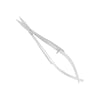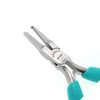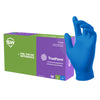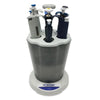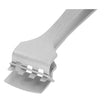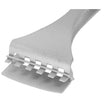- No products in the cart.
Best Tweezers for Building Electronics in Your Tech Lab
Jun
12
2020
When a laboratory is involved in building electronics or manipulating electronic components, it’ll need the right tools to make sure that nothing is fumbled or too small to pick up. For most laboratories, this means that they’ll need an extensive collection of tweezers to serve their needs. Not all tweezers are suited for work in an electronics lab, however.
Some tweezers might be better disposed to comfortable and precise operations than others, but it may not be clear which is which for labs which are just getting started. Taking a look at the properties worth hunting for in a pair of electronics tweezers will shed light on the issue and help to inform a purchasing decision.
What Should Labs Look For In A Pair of Tweezers For Electronics?
While the specific requirements for the best electronics-building-friendly tweezers will vary from lab to lab, there are a few features which most labs will benefit from having in their tweezers:
- Precision
- Comfort
- Cutting capability
- Anti-magnetic metal
Each of these features is more complex than it may appear at first glance. In fact, with the exception of anti-magnetic metal, each of the tweezer features influence the others. Furthermore, not all laboratories will find that each feature is of equal value to the others—but it’s essential to understand which tweezer features might be useful in the future as well.

Precision
Tweezer precision is critical because electronic components tend to be very small. Without fine-tipped prongs that are set at the correct angle, it becomes difficult to carefully pick up and manipulate transistors and other components gracefully. Similarly, if the prongs are too large, they may get in the way of other tools like the soldering iron.
As far as the angle of the prongs, most of the time the operator will have the clearest view of the component being manipulated when the prongs are set at an angle relative to the area that the operator holds. Some prongs are set at sharp 90-degree angles, whereas others are set at shallower 65-degree angles or even 45-degree angles.
In many cases, the most precise tweezers are those that are set at roughly 65 degrees, as this is typically the best balance between ease of use and leaving the operator with a clear view of small components under magnification.
Comfort
Tweezer comfort is a core feature, especially for laboratories in which lab personnel will be spending significant amounts of time working with their set of tweezers. For tweezer comfort, the most important things to consider are the grip type and the prong angle. Many tweezers have a gripping surface which has hashing which helps the operator to grip the tweezers even when they are wearing a pair of gloves; denser hashing provides more traction, but it’s also less pleasant to touch, so most personnel have a preference for modest hashing on the grip.
The prong angle of a pair of tweezers is less subject to operator preference. Tweezers with non-angled prongs are less comfortable to use because they require the operator to engage their wrist substantially more than they might otherwise. Similarly, tweezers with prongs angled at 90 degrees require the operator to engage their wrist in the opposite direction, which can also be uncomfortable. Thus, most operators prefer prongs that are angled at 65 degrees, as it requires the least wrist movement during electronics assembly.
Cutting Capabilities
For laboratories which manufacture electronics, it’s often useful to have a pair of tweezers which can be used to cut or partially strip wiring. Cutting tweezers fulfill this role. Though not all of a laboratory’s tweezers need to be cutting tweezers, retaining a handful of cutting tweezers ensures that lab personnel won’t have to reach for dedicated wire cutters when they’re working with wired components.
Cutting tweezers aren’t always the most comfortable or the most precise to use, however, and sometimes personnel may find that they must take great care to avoid damaging a component due to the sharp edges of the cutting surfaces. Similarly, many cutting tweezers lose the sharpness of their cutting surfaces relatively quickly, and their small size can be difficult to sharpen again.
The cutting surfaces of cutting tweezers which don’t lose their sharpness are often made from expensive materials like diamond, meaning that it’s also impractical to purchase the high-end cutting tweezers for many labs. This means that cutting capabilities are sometimes more problematic to use than tweezers without the ability to cut.
Anti-Magnetic Materials
Antiferromagnetism is a valuable feature for tweezers intended for assembling electronics because anti-magnetic tweezers retain their precision even when they’re exposed to magnetic fields or magnetic components. While it isn’t necessary for 100% of a laboratory’s tweezers to be anti-magnetic, retaining several anti-magnetic tweezers will guarantee that working with magnetized components will be significantly easier and less error-prone than it would be otherwise. For labs working with powerful magnetic fields, there’s no other tweezer solution which will work.
Which Brands of Tweezers Are The Best?
While there are many tweezer manufacturers to choose from, not all brands are ideal for electronics assembly work. Tweezer brands designed for use in biological laboratories are frequently uncomfortable and too imprecise for electronics manufacturing work, but they may not be labeled as such.
To avoid the wrong brand of tweezer, it’s useful to follow an established manufacturer. Excelta tweezers have a longstanding reputation for excellence among laboratories devoted to manufacturing electronics. If you’re not sure which Excelta tweezer your lab will benefit from the most, check out LabPro’s guide to choosing the right Excelta Tweezer.
Aside from Excelta tweezers, laboratories seeking to find the right brand or the right type of tweezer for electronics assembly will benefit from working with a qualified lab supply company. When electronics labs work with the right supplier, they can get the tools they need right when they need them so that they can be the best at what they do.
For over 40 years, Lab Pro has been committed to providing critical electronics laboratory supplies like tweezers in California and worldwide. Come visit the biggest Lab Supply showroom in California, or contact us online or at 888-452-2776.














